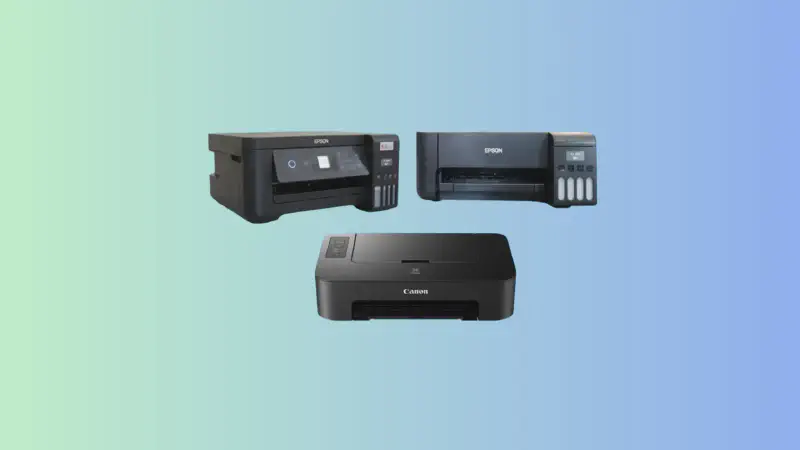# Introduction
Even though many businesses are going paperless, printers are still a big part of our work life. Some people like having a paper copy of important documents or use them as a backup. In this blog, I’m going to talk about the different kinds of printers that people still use a lot.
# What is a printer?
A printer is an electronic device that accepts text files or images from a computer and transfers them to a medium such as paper or film. They can directly connect to a computer or network, catering to various needs. Let’s explore the different types:
# Impact Printers
These rely on physical contact to produce text or images.
- Dot-Matrix Printers: Known for their ‘pin striking’ mechanism against an inked ribbon, creating characters on paper.
- Line Printers: Capable of printing a whole line at once, they are ideal for high-volume printing tasks in large organizations.
# Non-Impact Printers
These printers operate without direct physical contact with the paper.
- Laser Printers: Popular in offices, they use laser technology for precision and high-quality text and graphics.
- Inkjet Printers: Perfect for home use, they spray fine droplets of ink to produce vibrant color prints, often used for photos.
- Thermal Printers: Utilize heat to transfer ink or create images on special paper, commonly used in label and receipt printing.
- LED Printers: Similar to laser printers but use LEDs. They are known for their efficiency and print quality.
- Dye-Sublimation Printers: Best for photo printing, they transfer dye onto paper for vivid and lasting images.
- 3D Printers: A leap into the future, these create three-dimensional objects, layer by layer, from materials like plastic or metal, revolutionizing manufacturing and prototyping.
# Laser Printers
# Key Components:
- Imaging Drum: Acts like a canvas, where the image is ‘painted’ with a laser. It attracts toner (powdered ink), transferring it onto paper. Some printers have the drum built into the toner cartridge, while others have it separately.
- Fuser Assembly: This is where heat and pressure come into play, melting the toner and bonding it permanently to the paper.
- Transfer Belt and Roller (Color Laser Printers): Uses four color toner cartridges: cyan, yellow, magenta, and black.
- Pickup Rollers: These rollers are designed to pick up one sheet of paper at a time.
- Separation Pad: Ensures only the top sheet of paper is picked up from the tray.
- Duplexing Assembly: Enables printing on both sides of the paper.
# Printing Process:
- Processing: The entire page is built and stored in the printer’s memory.
- Charging: The imaging drum is coated with a negative electrostatic charge.
- Exposing: The laser “paints” the image onto the drum.
- Developing: Toner adheres to the charged areas of the imaging drum.
- Transferring: Toner is transferred from the drum onto the paper.
- Fusing: Heat and pressure are applied to melt the toner.
- Cleaning: Any excess toner is removed from the imaging drum.
# Inkjet Printers
# Key Components:
- Ink Cartridge: These cartridges hold the ink used for printing.
- Print Head: Where the ink is actually applied to the paper.
- Feed Rollers: Pick up and feed paper through the printer.
- Carriage and Belt: The carriage holds and moves the ink cartridges.
- Printer Calibration Tools: Used to align the print nozzles.
# Printing Process:
- Image Creation: Begins with a digital image on your computer.
- Image Understanding: Printer calculates the number of ink droplets.
- Ink Ejection: Printhead moves back and forth, ejecting ink droplets.
- Droplet Formulation: Control of droplet size and placement.
- Paper Handling: Paper is advanced through the printer.
- Color Mixing: Different-colored droplets blend to create images.
- Absorption & Drying of Ink: Ink droplets are absorbed and dried.
# Thermal Printers
# Components:
- Thermal Printhead: The heart of the printer.
- Ribbon Unwind: Holds the roll of TTR.
- Label Unwind: Holds the label roll.
- Platen Roller: Positioned right under the thermal printhead.
- Ribbon Take-Up Spindle: Wound onto this spindle after passing through the printhead and platen roller.
# Printing Process:
- When the printhead’s elements heat up, they melt the ink from the TTR.
- This melted ink is then transferred onto the substrate, creating the desired image.
- The ink used in TTR is typically wax, resin, or a wax-resin blend.
- Favored for high-resolution barcode labeling and similar applications.
# Conclusion
In conclusion, understanding the various types of printers and their respective processes is crucial in today’s digital world. From the precision and speed of laser printers to the color-rich outputs of inkjets, and the heat-based efficiency of thermal printers, each type offers unique benefits suited to different needs. Whether it’s for an office, personal use, or specialized industrial applications, comprehending their mechanisms and functionalities enables users to make informed decisions. This understanding ensures efficiency and quality in their printed materials.
